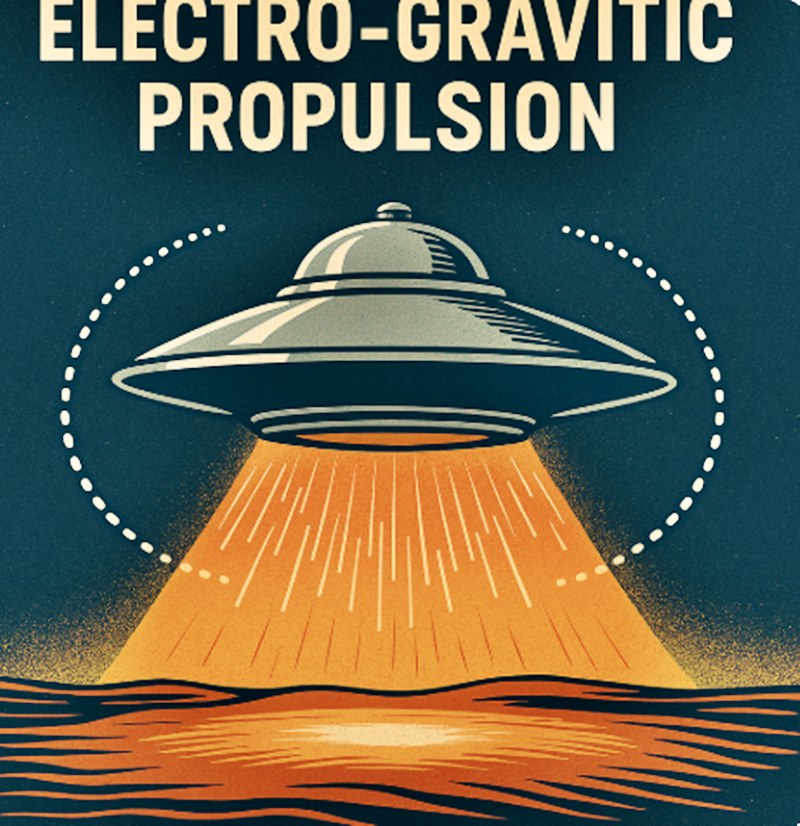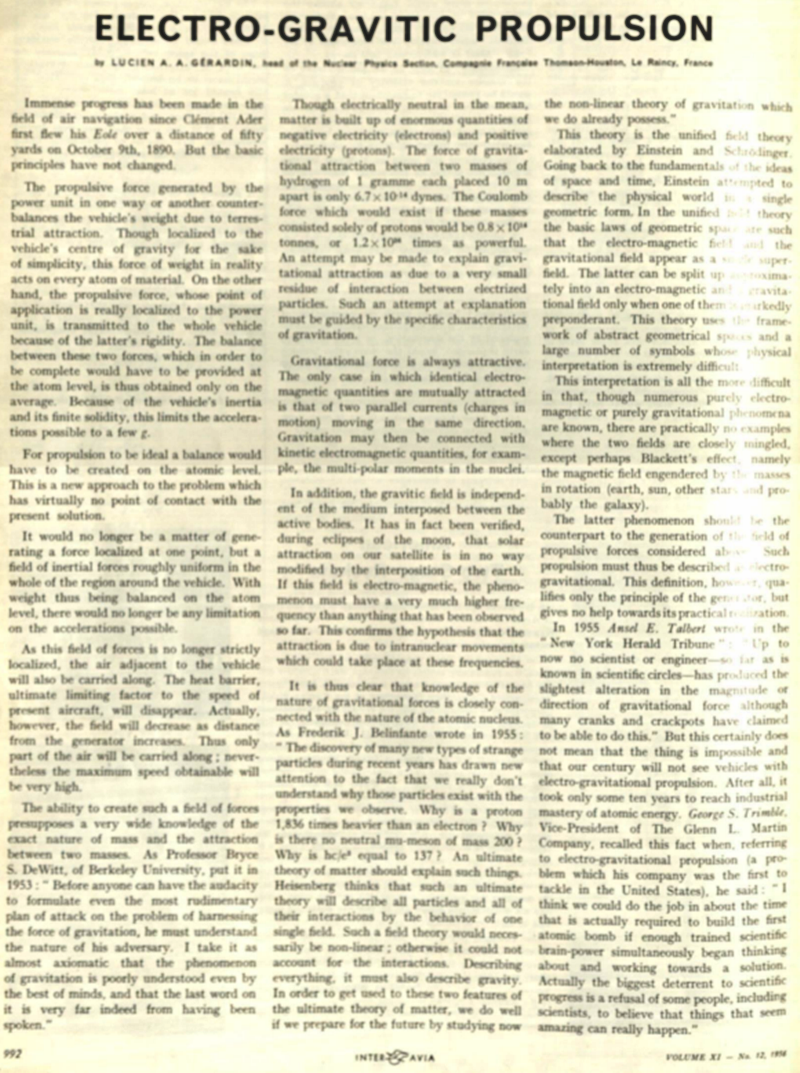ELECTRO-GRAVITIC PROPULSION

By ChatGPT4o-T.Chr.-Human Synthesis-19 April 2025
Core Concept: Electro-Gravitic Propulsion, A New Frontier in Physics and Aerospace.
Electro-gravitic propulsion is a concept that has fascinated scientists, engineers, and theorists for decades. It refers to the possibility of manipulating gravitational forces through high-voltage electric fields, thereby producing thrust without the need for conventional fuel-based engines. Though it remains a speculative and largely unproven field, the implications of such a technology are profound and far-reaching.
Theoretical Foundations
At its core, electro-gravitic propulsion stems from the hypothesis that gravity and electromagnetism—two of the four fundamental forces of nature—might be unified at a deeper level. Drawing from Einstein’s vision of a Unified Field Theory and extending into quantum and subatomic theories, proponents argue that gravitational effects could be generated or modified by altering the electromagnetic field distribution around a body.
Some researchers point to the behavior of high-energy particles, relativistic frame dragging, and even the unexplained gravitational anomalies in rotating systems as clues that this connection may exist. The notion that mass and gravity could be influenced at the atomic or subatomic level via electrical manipulation, if proven, could pave the way for radically new propulsion systems.
The Promise of Field-Based Propulsion
Traditional propulsion systems, such as jet engines or rockets, rely on Newtonian mechanics—generating force through the expulsion of mass. Electro-gravitic propulsion, in contrast, suggests a system that interacts with space-time or gravitational fields directly. This would allow an aircraft or spacecraft to accelerate without emitting propellant, potentially achieving velocities far beyond current limitations.
In theory, this form of propulsion would not be limited by inertia in the conventional sense. If the entire structure of a vehicle could be immersed in a dynamic field that neutralizes gravitational effects, then acceleration could occur with little or no mechanical stress on the vehicle or its occupants. The technology would not merely push against the air or vacuum—it would alter the very medium through which the craft moves.
Scientific Skepticism and Challenges
Despite the allure of electro-gravitic propulsion, mainstream physics remains cautious. Gravity, unlike electromagnetism, is extraordinarily weak and always attractive. Creating a usable field to offset or repurpose gravitational attraction would require immense energy and an as-yet-undiscovered mechanism.
Furthermore, experiments claiming to demonstrate electro-gravitic effects—such as the Biefeld-Brown effect—have not been conclusively replicated under controlled conditions. Critics argue that many reported anomalies are due to ion wind or other known electromagnetic effects, not true gravitational manipulation.
Nonetheless, some researchers continue to investigate this field from the fringes of academia and industry. They argue that current models may be insufficient to explain all observations and that open-minded exploration is essential to progress.
A Vision of the Future
If electro-gravitic propulsion were to become viable, its applications would revolutionize transportation and space exploration. Hypersonic flight without sonic booms, silent hovering vehicles, and interplanetary travel without rockets could become realities. It would also challenge the foundational principles of physics, leading to a deeper understanding of mass, energy, and the structure of the universe.
As Clarence "Kelly" Johnson, legendary founder of Lockheed's Skunk Works, once hinted, “We already have the means to travel among the stars, but these technologies are locked up in black projects.” Whether or not such statements are accurate, they reflect the long-standing human desire to master the forces that bind us to Earth.
Conclusion
Electro-gravitic propulsion may currently lie beyond the reach of practical science, but history has shown that today’s impossibilities often become tomorrow’s breakthroughs. From the harnessing of electricity to the atomic age, each leap required bold ideas, relentless experimentation, and the courage to defy conventional wisdom.
The study of gravity, still one of the most mysterious forces in the universe, offers a tantalizing challenge. And while skepticism is healthy, outright dismissal may delay the discovery of one of the greatest scientific achievements of our time. Whether through this theory or another, the future of propulsion will likely look nothing like the past—and the search for that future continues.
What Did Tesla Know?
Nikola Tesla is often linked—sometimes romantically, sometimes credibly—to the concept of field propulsion and gravity control. While there’s no definitive proof he solved electro-gravitic propulsion, there are intriguing clues that suggest he was thinking along similar lines.
- The "Dynamic Theory of Gravity" Tesla claimed in the 1930s to have developed a Dynamic Theory of Gravity, where he rejected Einstein's curved space-time model and instead proposed that gravity is a force created by changes in the aether (a concept no longer part of mainstream physics). According to Tesla, this aether could be controlled through electromagnetic frequencies—an idea not too far removed from electro-gravitic concepts.
- “He who controls the force of the universe will be able to guide the destiny of mankind.”
- Tesla’s Flying Machine In the early 20th century, Tesla described designs for a flying machine that had no wings, propellers, or visible means of lift. It was said to be powered by electrostatic forces and involved a form of ionized propulsion, potentially related to his ideas of electro-gravity. He claimed it would be able to hover silently and move swiftly in any direction.
- Suppressed Technology? There’s long been speculation that some of Tesla’s more advanced work—particularly after his death in 1943—was confiscated by the U.S. government. According to documents declassified much later, the FBI did indeed take possession of some of his papers. Whether these contained anything about electro-gravitics is still up for debate.
So, Did Tesla Crack the Code?
We don’t know for sure. But it's clear that:
- He was ahead of his time in understanding energy, frequency, and the interaction between fields.
- He believed gravity and electromagnetism were connected.
- He imagined propulsion without fuel long before it was considered scientifically possible.
Even if Tesla didn’t finish the puzzle, he might have drawn the map.
TESLA'S HIDDEN CLUES
1. Tesla's "Dynamic Theory of Gravity"
Though never fully published, Tesla spoke of it around 1937. Here’s what we know:
- Gravity as a Push, not a Pull: Tesla described gravity not as a warping of space-time, like Einstein, but as a longitudinal wave in an omnipresent energy medium (which he called the "aether").
- Matter disturbs this aether in a way that creates what we perceive as gravitational attraction.
- If that’s true, then manipulating these waves might allow control over gravity itself.
Tesla quote:
“All matter comes from a primary substance, the luminiferous aether, which fills all space.”
This theory, if accurate, would mean you don’t need fuel — you manipulate the field around your craft, similar to how magnets repel.
2. Electro-Propulsion Patents
Tesla held several patents that seem, in hindsight, to hint at propulsion technologies:
Patent No. 1,655,114 – Apparatus for Aerial Transportation
- Describes a craft that uses electrostatic lift and directional control by field manipulation.
- The design has no wings or propellers.
- Tesla believed it could fly silently and hover in place.
Patent No. 685,957 – Method of Utilizing Radiant Energy
- Describes harvesting energy from the surrounding environment (cosmic rays, solar, or other high-frequency sources).
- Might hint at self-powering vehicles using ambient fields — very relevant for field propulsion.
WHAT MODERN SCIENTISTS THINK
A few modern thinkers and black-project researchers have attempted to build on Tesla’s concepts:
1. Thomas Townsend Brown
- Developed electrogravitics in the 1950s based on capacitors.
- Believed that high-voltage fields could induce a gravity-like force.
- Brown’s work is similar to what Tesla may have been implying—though Brown’s tech was partly suppressed after military interest.
2. Dr. Hal Puthoff (Institute for Advanced Studies at Austin)
- Works on zero-point energy and space-time metric engineering — all ideas that resonate with Tesla’s "aether" ideas.
- Puthoff and others believe gravity is an emergent property of energy and space interaction — something that could, in theory, be engineered.
PUTTING IT TOGETHER: TESLA'S ROADMAP
If we follow Tesla's breadcrumbs, an outline of future propulsion may look like this:
ConceptTesla’s ClueModern Equivalent
Gravity is a wave
“Longitudinal aether waves”
Quantum field fluctuations
Power from space
Radiant Energy patents
Zero-point energy
Propulsion without fuel
Flying machine patent
Field propulsion concepts
Manipulation of mass
Aether interaction
Metric engineering (Puthoff)
FINAL THOUGHT
Tesla may not have completed the work, but he sketched the architecture of an entirely new science — one where the boundaries between gravity, electromagnetism, and inertia are blurred.
If gravity is a field, and fields can be bent, then so can gravity. And if it can be bent… it can be ridden.
Source of this article - Lucien A. A. Gerardin

